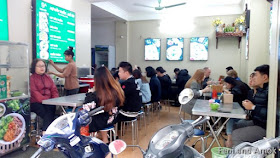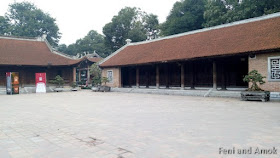My 6-day motorbike ride was done - around Mai Chau, Moc Chau, Pu Luong and Ninh Binh - and I was back in Ha Noi. I had planned the Free Walking Tour conducted by students before I had arrived in Vietnam by contacting the manager through the web site www.hanoifreewalkingtours.com.
Mr Son, a student of Architecture, arrived promptly at my hotel Hanoi Guest House a little before 9 a.m. After brief introductions and an overview, we were on our way.

 Our first stop was to be the Ho Chi Minh Mausoleum about 30 minutes walk from the Old Quarter. It was going to be a day of lots of walking and standing, about 6 hours or so.
Our first stop was to be the Ho Chi Minh Mausoleum about 30 minutes walk from the Old Quarter. It was going to be a day of lots of walking and standing, about 6 hours or so. Our first stop was to be the Ho Chi Minh Mausoleum about 30 minutes walk from the Old Quarter. It was going to be a day of lots of walking and standing, about 6 hours or so. We passed a large statue of Lenin along the way, worth taking a picture. I guess not many such statues are found around the world. We also
passed the Military Museum, with the red and gold star Vietnamese flag fluttering proudly on top.

The Ho Chi Minh Mausoleum is the final resting place of Vietnamese Revolutionary leader Ho Chi Minh. Located in Hanoi it is it is a large, sombre looking building in Ba Dinh Square. Ho Chi Minh (affectionately known as Uncle Ho), was President of the Communist Party, and read out the Declaration of Independence on 2 September 1945, establishing the Democratic Republic of Vietnam. Tickets need to be bought at the entrance, and lines tend to be long, as soldiers keep a watchful eye on visitors. Dress regulations must be followed strictly. Photography is not allowed near and inside the Mausoleum. Two lines must be formed. The atmosphere is rather serious as visitors file into the Mausoleum where Uncle Ho's body is embalmed and preserved.
The complex is immaculately maintained. Other large buildings include the Presidential Palace where Uncle Ho rarely stayed, rather, he used it to meet visiting dignitaries.



 He stayed for several years in a smaller building, the facade and rooms have been maintained as it was at that time. The cars he used have also been preserved, all of them gifts that he refused to sell or give away.
He stayed for several years in a smaller building, the facade and rooms have been maintained as it was at that time. The cars he used have also been preserved, all of them gifts that he refused to sell or give away. During the tour, we were joined by a lady and her 3-year son. The little boy was running around, and naturally found it a little hard to stay still while waiting in line to enter the Mausoleum - under the watchful gaze of soldiers.

Ho Chi Minh encouraged the development of greenery, proof of which is the large garden with fountains, and an orchard. We also got a glimpse into the humble home where Ho Chi Minh lived in most of the time, beautifully preserved. It is rather commendable that historical buildings and gardens have been preserved so very immaculately.




Surprise, huge surprise, indeed! Who should I bump into there but my colleague who I used to work with over 5 years ago!
The complex is a fairly large area to walk in, and includes a Museum and the well known Single-Pillar Pagoda.

As we continued our walking tour, it was time to take a coffee break at Twenty Coffee near the Mausoleum, a quiet relaxed cafe.
Next stop: The Temple of Literature. It is a Temple of Confucius (and his disciples), and housed the Imperial Academy, Vietnam's first national university. The temple was built in 1070 at the time of Emperor Ly Thai To. It is one of several temples in Vietnam which is dedicated to Confucius, sages and scholars.


t
My guide explained the pavilions, halls, statues and stelae of doctors, places where offering ceremonies, study sessions and the strict exams took place. Altars always have five types of objects - representing the five elements.
The largest shrine is dedicated to Confucius and his four disciples.
Confucius' four disciples.


Our next stop would be the Old Quarter via the edge of the French Quarter. On the way we passed a railway track that is still used. There is no signal and there is no gate!
We passed St Joseph Cathedral near the French Quarter, all decorated for the Christmas season.


It was soon time for lunch at a little restaurant in the Old Quarter. we ordered a bowl of pork noodles each.
The restaurant seems to be one of the perpetually crowded ones.


Ho Chi Minh stayed in a house in the Old Quarter for a while, belonging to a businessman, and this is where he wrote the Declaration of Independence. The house is on Hang Ngang Street.
Not very far away, again in the Old Quarter, is the Bach Ma Temple or White Horse Temple.
The temple was built in 1070 by Emperor Ly Thanh Tong (Ly Thai To) in honour of a White Horse that, according to legend, helped demarcate the city of Ha Noi to the Emperor. An outer altar can be seen, an inner altar dedicated to Lord Buddha along with an ornamental palanquin, and an altar outside dedicated to the Goddess of Mountains, Sky and Waters. Odd numbers are considered sacred. For example, three incense sticks are burnt, my guide informed me.
The Bach Ma Temple is rather peaceful, quite a contrast to the cacophony on the streets of the Old Quarter.
My guide also explained to me the Old Gate of the Old Quarter, and the significance of the Vietnamese flag fluttering alongside.
For eatables to be found along the streets, how about this store where you can see live worms on the trays at the right side bottom, and fried worm pancakes next to the trays?
Walking along past the huge market in the Old Quarter, we made our way past the Lake to the French Quarter. A festive air hung around the streets, it was almost Christmas and the holiday season. Dance groups, singing groups, and groups played (kicked) balls and any object, the idea being to keep the object above the ground.
Vietnamese children took the opportunity of practicing English with visitors, while some played games and made towers made of little pieces of wood. Overall, there was a major festive air by the Lake.
Delicious Trang TIen ice cream from the most famous outlet en route to the majestic Opera House.
The French Quarter consists of large buildings, wide avenues, lots of trees and parks, very different from the commercial Old Quarter which has a delightful flavour of its own.
Well, here is another tour group, comprising of the team lead Ms Suong with a guest. Nice to meet you again! We had met earlier at the Temple of Literature. Have a nice day, and enjoy Ha Noi!
My guide Mr Som and I wandered along, this time to the lovely Tower set in a neat garden, with the turtle and dragon at the bottom. Kids played on the badminton courts.
The imposing status of Emperor Ly Thai To, the founder of the dynasty and a highly respected Emperor, is found in the French Quarter.
As we walked back, my guide explained the history of the Lake of the Restored Sword and the Turtle Tower.
Mr Som, a student of architecture, had taken the trouble of sketching the Turtle Tower for me, and handed it to me at the end of the tour. Thank you for your thoughtful gesture, Mr Som!
Thank you for guiding me around Ha Noi, Mr Som. A most memorable tour, indeed. And, thank you vsery much for the sketch of the Temple of the Turtle Tower.
We were now at the Puppet Theatre by the lake. It was close to 8 hours since we had left my hotel in the morning. I had about 20 minutes to wait for my evening Water Puppet show.
Thank you for joining my guide and me on the full day walking tour of Ha Noi.
Please click here for: Ha Noi Evening Walking Food Tour (Old Quarter).
For more information on Free Walking tours, please visit:
http://www.hanoifreewalkingtours.com/
or email:
info@hanoifreewalkingtours.com
This series of my adventures in North Vietnam is pictured here:
-=-=-=-=


































